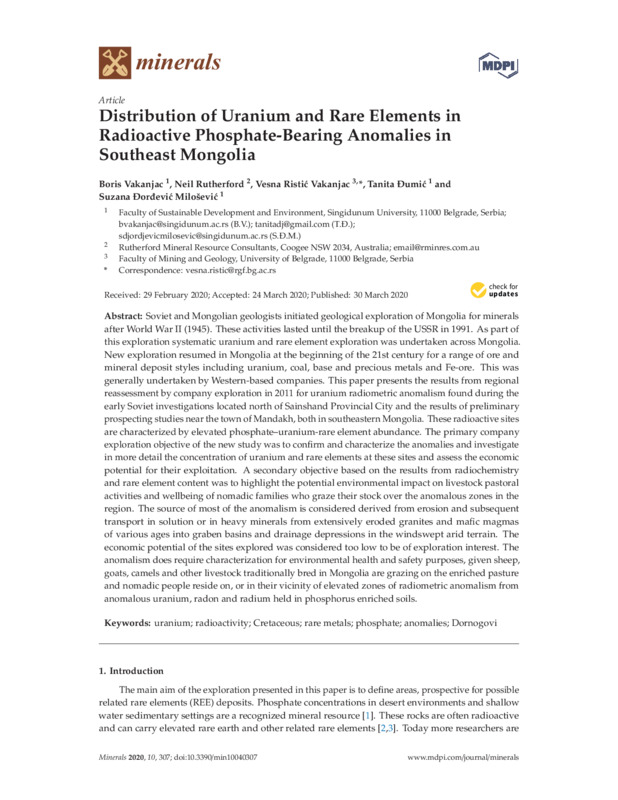Distribution of Uranium and Rare Elements in Radioactive Phosphate-Bearing Anomalies in Southeast Mongolia
Објеката
- Тип
- Рад у часопису
- Верзија рада
- објављена верзија
- Језик
- енглески
- Креатор
- Boris Vakanjac, Neil Rutherford, Vesna Ristić Vakanjac, Tanita Đumić, Suzana Đorđević Milošević
- Извор
- Minerals
- Издавач
- MDPI AG
- Датум издавања
- 2020
- Сажетак
-
Soviet and Mongolian geologists initiated geological exploration of Mongolia for minerals after World War II (1945). These activities lasted until the breakup of the USSR in 1991. As part of this exploration systematic uranium and rare element exploration was undertaken across Mongolia. New exploration resumed in Mongolia at the beginning of the 21st century for a range of ore and
mineral deposit styles including uranium, coal, base and precious metals and Fe-ore. This was generally undertaken by Western-based companies. This paper presents the results from regional reassessment by company exploration in 2011 for uranium radiometric anomalism found during the early Soviet investigations located north of Sainshand Provincial City and the results of preliminary prospecting studies near the town of Mandakh, both in southeastern Mongolia. These radioactive sites are characterized by elevated phosphate–uranium-rare element abundance. The primary company exploration objective of the new study was to confirm and characterize the anomalies and investigate in more detail the concentration of uranium and rare elements at these sites and assess the economic potential for their exploitation. A secondary objective based on the results from radiochemistry and rare element content was to highlight the potential environmental impact on livestock pastoral activities and well being of nomadic families who graze their stock over the anomalous zones in the region. The source of most of the anomalism is considered derived from erosion and subsequent transport in solution or in heavy minerals from extensively eroded granites and mafic magmas of various ages into graben basins and drainage depressions in the windswept arid terrain. The economic potential of the sites explored was considered too low to be of exploration interest. The anomalism does require characterization for environmental health and safety purposes, given sheep, goats, camels and other livestock traditionally bred in Mongolia are grazing on the enriched pasture and nomadic people reside on, or in their vicinity of elevated zones of radiometric anomalism from anomalous uranium, radon and radium held in phosphorus enriched soils. - том
- 10
- Број
- 4
- број страница
- 18
- doi
- 10.3390/min10040307
- issn
- 2075-163X
- Просторно покривање
- Mongolija
- Subject
- uran, radioaktivnost, kreda, retki elementi, fosfati, anomalije, Dornogobi
- uranium, radioactivity, Cretaceous, rare metals, phosphate, anomalies, Dornogovi
- Шира категорија рада
- M20
- Ужа категорија рада
- М22
- Права
- Отворени приступ
- Лиценца
- Creative Commons – Attribution-NonComercial 4.0 International
- Формат
- Медија
 V Ristic Vakanjac_RB 202.pdf
V Ristic Vakanjac_RB 202.pdf
Boris Vakanjac, Neil Rutherford, Vesna Ristić Vakanjac, Tanita Đumić, Suzana Đorđević Milošević. "Distribution of Uranium and Rare Elements in Radioactive Phosphate-Bearing Anomalies in Southeast Mongolia" in Minerals, MDPI AG (2020). https://doi.org/10.3390/min10040307 М22
This item was submitted on 20. новембар 2023. by [anonymous user] using the form “Рад у часопису” on the site “Радови”: http://drug.rgf.bg.ac.rs/s/repo
Click here to view the collected data.